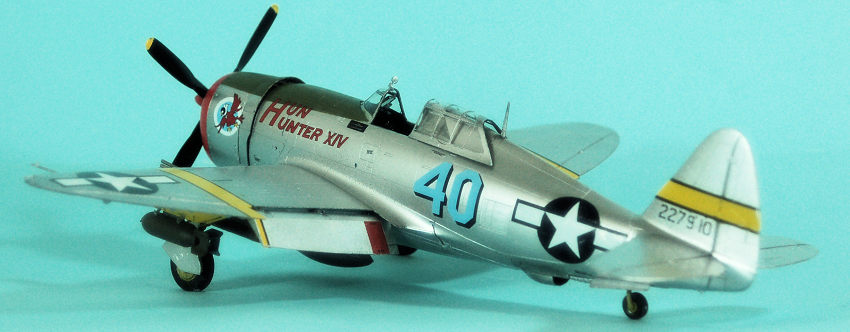
Tamiya 1/48 P-47D Thunderbolt
| KIT #: | 61086 |
| PRICE: | $49.95 SRP |
| DECALS: | Two options |
| REVIEWER: | Tom Cleaver |
| NOTES: | Aeromaster 48-083 “Thunderbolts Galore II” decals |

| HISTORY |
Little need be written here about the P-47. However, the P-47D “Hun Hunter XIV” is well-known, having appeared in the documentary “Thunderbolt” made by William Wyler and John Sturges during World War II.
Not much has been written about the 57th
Fighter Group, the first USAAF unit to enter combat in the European Theater when
their P-40Fs were launched from USS Ranger off the coast of Africa at the end of
July 1942. After making their way across equatorial Africa to Egypt, the unit
flew with the RAF at El
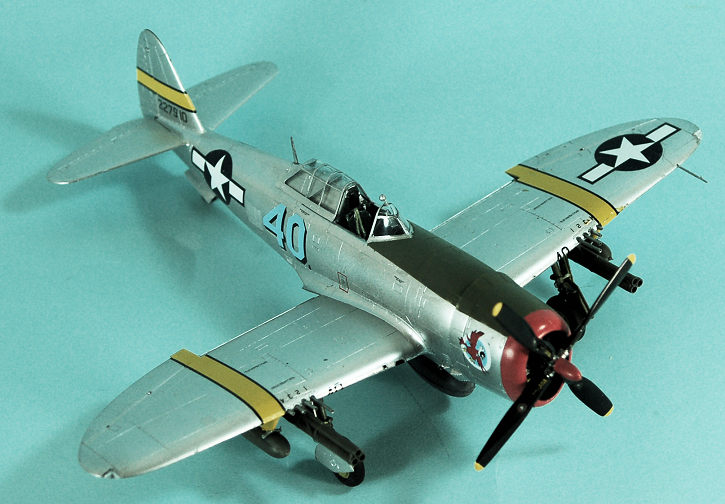 Alamein and
the campaign across North Africa, notably taking part in the “Palm Sunday
Massacre,” during which the P-40 pilots shot down 75 German aircraft, some 60 of
which were the vulnerable transports with Bf-110 and a few Bf-109 fighter
escorts accounting for the remainder. It was the greatest victory by American
fighters in the course of combat in the Mediterranean Theater.
Alamein and
the campaign across North Africa, notably taking part in the “Palm Sunday
Massacre,” during which the P-40 pilots shot down 75 German aircraft, some 60 of
which were the vulnerable transports with Bf-110 and a few Bf-109 fighter
escorts accounting for the remainder. It was the greatest victory by American
fighters in the course of combat in the Mediterranean Theater.
The group then took part in the Sicilian campaign and on into Italy, transitioning from their well-worn P-40s to P-47s in December 1943. From then until the end of the war, they flew fighter-bomber missions.
An idea of just what being a P-47 fighter bomber pilot in Italy involved can be found in the words of Michael C. McCarthy, who arrived a 2nd Lieutenant pilot in May 1943, shortly after his 19th birthday, and survived to become Group Operations Officer and promoted to Major a month before his 21st birthday in March 1945: “ “The air-to-ground environment is brutal, life threatening, and consistently dangerous. The fighter pilot population in our squadron changed 400 percent from May 1943 until the end of the war in June 1945. We lost airplanes and pilots on a regular basis. We changed tactics, varied approaches and routes to targets, and emphasized surprise at every opportunity. In the end, we learned that you must fly down the enemy’s gun barrel to destroy the target.”
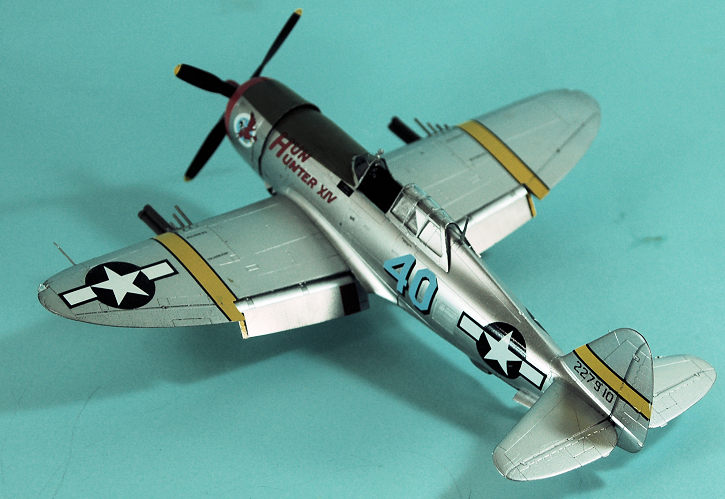 Alone among
American air force fighter units, the 57th Fighter Group followed a command
philosophy that required proven ability in combat, not rank or time in the unit,
be the basis for selection of element, section, flight, and squadron leaders. As
McCarthy recalled, “We followed that policy without exception during my 27
months with the group. In some cases, a captain or major, newly assigned, might
fly a complete tour as a wingman and fail every chance to lead an element or a
section. It was odd to see a squadron of 16 ships led successfully by a young
first lieutenant with a field grade officer riding his wing, but the policy
saved lives, put the strongest pilots in lead positions, and produced
exceptional combat results.” In the group, a new pilot was known as a “Sprog.”
Once he had survived 15-20 missions and demonstrated some ability, he was
promoted to “Sport.” If he survived half a tour, he became an “Old Sport.” Those
“Old Sports” who showed skill as well as ability were promoted into unit
leadership as positions opened through completion of tour, transfer or death,
and were the “Wheels” of the group.
Alone among
American air force fighter units, the 57th Fighter Group followed a command
philosophy that required proven ability in combat, not rank or time in the unit,
be the basis for selection of element, section, flight, and squadron leaders. As
McCarthy recalled, “We followed that policy without exception during my 27
months with the group. In some cases, a captain or major, newly assigned, might
fly a complete tour as a wingman and fail every chance to lead an element or a
section. It was odd to see a squadron of 16 ships led successfully by a young
first lieutenant with a field grade officer riding his wing, but the policy
saved lives, put the strongest pilots in lead positions, and produced
exceptional combat results.” In the group, a new pilot was known as a “Sprog.”
Once he had survived 15-20 missions and demonstrated some ability, he was
promoted to “Sport.” If he survived half a tour, he became an “Old Sport.” Those
“Old Sports” who showed skill as well as ability were promoted into unit
leadership as positions opened through completion of tour, transfer or death,
and were the “Wheels” of the group.
 Among
the group’s “Wheels” was Gil Wymond, who eventually flew 16 “Hun Hunters” as he
became one of the few original members to serve through the whole war over three
combat tours. Born on September 23, 1919, in Louisville, Kentucky, he enlisted
in the Aviation Cadet Program of the U.S. Army Air Corps on April 25, 1941, and
was commissioned a 2d Lt and awarded his pilot wings at Kelly Field, Texas, on
December 12, 1941. Among his classmates were George Preddy and John D. Landers.
Among
the group’s “Wheels” was Gil Wymond, who eventually flew 16 “Hun Hunters” as he
became one of the few original members to serve through the whole war over three
combat tours. Born on September 23, 1919, in Louisville, Kentucky, he enlisted
in the Aviation Cadet Program of the U.S. Army Air Corps on April 25, 1941, and
was commissioned a 2d Lt and awarded his pilot wings at Kelly Field, Texas, on
December 12, 1941. Among his classmates were George Preddy and John D. Landers.
Joining the 65th Fighter Squadron of the 57th Fighter Group at Bradley Field shortly before Christmas, 1941, h went aboard the aircraft carrier USS Ranger (CV-4) in July 1942. On July 19, 1942, they were launched off The Gold Coast and arrived at Accra.
Between August 1942 and May 1945, Lt Col Wymond moved with his squadron through Egypt, Libya, Tunisia, Malta, Sicily, and Italy. He flew 153 combat missions, was credited with the destruction of three enemy aircraft in combat plus 2 probables, and served as Commanding Officer of the 65th Fighter Squadron from May 1943 to May 1945, with short periods on leave in the United States from July to September 1943, and May to June 1944.
After the war Lt Col Wymond took command of the 55th Fighter Squadron at Shaw AFB, South Carolina, in April 1949, and was killed in the crash of his F-84 Thunderjet on May 11, 1949.
| THE KIT |
Hey, it's a Tamiya kit and considered the “definitive” P-47 razorback kit. Unless you are too illiterate to read the instructions, and too ham-fisted to touch the parts without breaking them, it is impossible for you to not "get it right" by following the instructions.
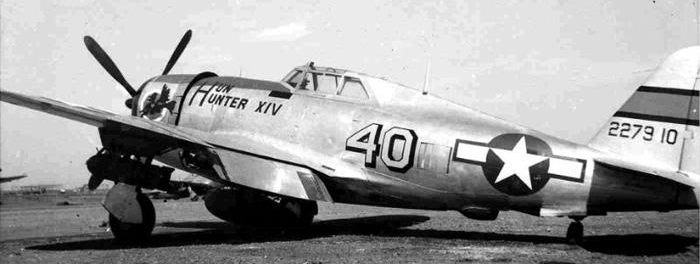 Having
acquired the Aeromaster sheet 48-083 “Thunderbolts Galore II” which has Hun
Hunter on it, I knew what markings I would use on this model. Unfortunately,
Errormaster lived up to its name. In fact, the squadron insignia on the nose is
incorrect as regards size and dimensions, and the instructions have one place
the yellow stripe on the vertical fin too low. I even had the photo I have
included here, which clearly shows the stripe going across the rudder trim tab,
and I made the mistake of believing Errormaster. Oh well...
Having
acquired the Aeromaster sheet 48-083 “Thunderbolts Galore II” which has Hun
Hunter on it, I knew what markings I would use on this model. Unfortunately,
Errormaster lived up to its name. In fact, the squadron insignia on the nose is
incorrect as regards size and dimensions, and the instructions have one place
the yellow stripe on the vertical fin too low. I even had the photo I have
included here, which clearly shows the stripe going across the rudder trim tab,
and I made the mistake of believing Errormaster. Oh well...
| CONSTRUCTION |
I painted all the detail - cockpit interior, wheel wells, engine, cowling, etc. - before removing the parts from the sprues, then assembled everything. Since the photo showed the airplane with the flaps lowered, I chose that option.
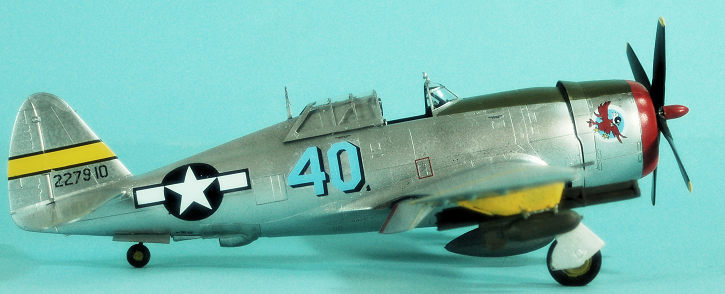 I painted the
nose white, then red, then masked that off and painted the anti-glare panel and
masked that off before I painted the rest of the model with Tamiya X-1 Gloss
Black, thinned to be misted on perfectly smooth. I then applied Vallejo “Duraluminum”
overall. I used “White Aluminum” brush painted (it leaves no brush marks) for
various panels.
I painted the
nose white, then red, then masked that off and painted the anti-glare panel and
masked that off before I painted the rest of the model with Tamiya X-1 Gloss
Black, thinned to be misted on perfectly smooth. I then applied Vallejo “Duraluminum”
overall. I used “White Aluminum” brush painted (it leaves no brush marks) for
various panels.
I used national insignia from a Cutting Edge sheet in the
dungeon, and also used number decals from that sheet since the serial number
supplied by Errormaster was too small (how they managed to get so many things so
wrong when this well-known photo of Hun Hunter XIV, which has been around
forever, was available to show everything right, is beyond me). The rest of the
decals came from the Errormaster sheet and were applied without problem. Ever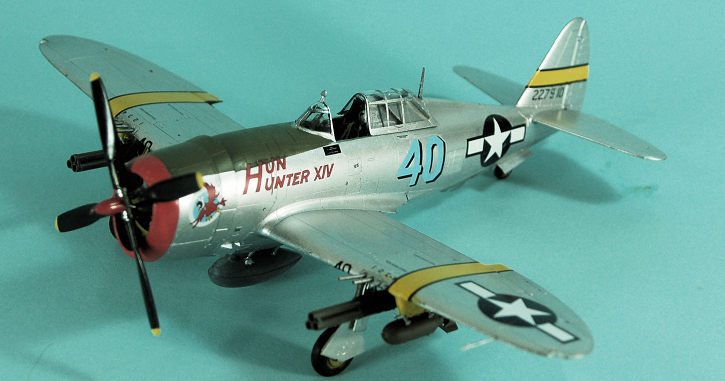 ything
fit, which was nice because the sheet originally came out when the only kit
available was the old Monogram kit and the decals were sized for it.
ything
fit, which was nice because the sheet originally came out when the only kit
available was the old Monogram kit and the decals were sized for it.
I attached the wing pylons after the decals set, then attached the landing gear and the bombs and rocket tubes. The 75-gallon tank came from a P-40 kit. I unmasked the canopy and attached it in the open position.
| CONCLUSIONS |
Hey! It’s the Tamiya P-47. Comfort food for modelers. You cannot go wrong with the kit, and there are still plenty of decals out there for all kinds of colorful P-47s. Recommended for everybody.
Thanks to my wallet for the kit and decals.
Copyright ModelingMadness.Com.
If you would like your product reviewed fairly and fairly quickly, please contact the editor or see other details in the Note to Contributors.
Back to the Main Page Back to the Review Index Page Back to the Previews Index Page